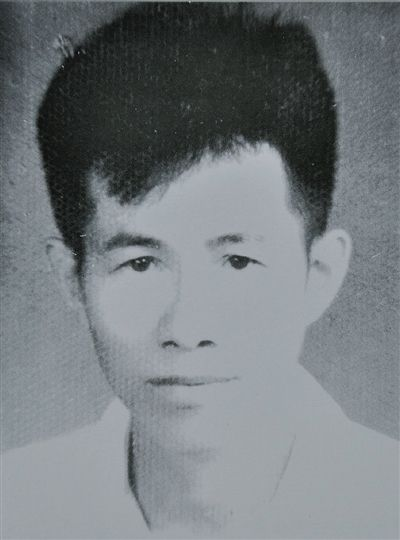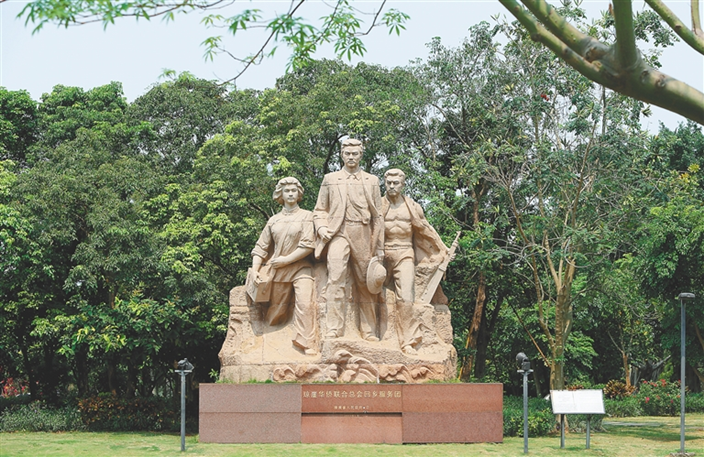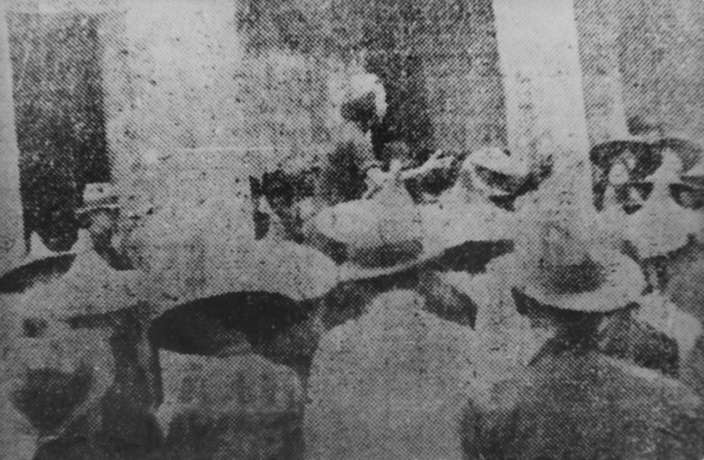By continuing to browser our site and use the services you agree to our use of cookies, Privacy Policy and Terms of Use. You can change your cookie settings through your browser.
Editor’s note:
This year marks the 80th anniversary of the victory in the Chinese People’s War of Resistance Against Japanese Aggression and the World Anti-Fascist War. The Qiongya campaign in Hainan formed a crucial part of this epic struggle. In the early 20th century, many Hainanese left their homeland to seek livelihoods in Southeast Asia. Through diligence and ingenuity, they not only built new lives but in many cases became local magnates. However, after the war erupted, groups of overseas Hainanese resolutely returned to their homeland to join the fight against the invaders.
“Our ancestral home is Canghai Village, Wenchang. Mired in poverty, my father went abroad (to Vietnam) to make a living at the age of 15,” wrote Fu Sizhi’s daughter, Fu Zhen, in a memoir of her father’s life. “Thanks to his skilled craftsmanship, life abroad was not especially hard. But his heart remained with his homeland. When news of Japan’s invasion reached him, he made the fateful decision to return and join the fight.”

Photo of Fu Sizhi (Archive photo)
In 1937, determined to resist the Japanese aggression, Fu Sizhi traveled from Vietnam to Hong Kong in China. There he connected with the local branch of the Communist Party of China and became a full-fledged member, formally committing himself to the cause of national salvation under Party leadership.
As the war escalated, large numbers of Hainanese compatriots overseas, including those in Hong Kong and Macau, likewise made the decision to return to their war-torn island homeland. Braving the Japanese army and navy’s land and sea blockades, they smuggled themselves back to embattled Hainan, bringing urgently needed medical supplies to the soldiers and civilians resisting the invaders. Among these volunteer returnee groups, the Hong Kong contingent was one of the first formed and the largest in size.

Bronze sculpture commemorating the Hainan (Qiongya) Overseas Chinese Returnees Service Corps, located on the Central Square of the Haikou Youth Activities Center. (Photo: Hainan Daily)
A vanguard crossing by sea under the cover of night
In early 1939, the Hong Kong group resolved to dispatch its first batch of volunteers to Hainan. Fu Sizhi was chosen to lead 32 team members, with departure set for February 11, 1939. However, at 3:00 a.m. on the scheduled day, grim news arrived: on February 10, the Japanese invaders had landed on Hainan and occupied the port city of Haikou.
As Chen Kegong, a member of the service corps, later recalled: “When the news came, the hall of Haisheng Club (where Hainanese compatriots gathered) was suddenly packed with our comrades. In an instant, some were seething with anger, some were distraught, and many others fell into silence. At that moment, Fu Sizhi gave everyone a brief but powerful pep talk, urging them to steady their emotions, make full preparations to return to Hainan and join the fight, and await new orders from the Hainan Overseas Chinese General Association (琼侨总会). His words were like a breath of spring, lifting the gloom that had settled in people’s hearts.
The Japanese occupation of Haikou did not discourage them, but instead strengthened their resolve. The first group of volunteers managed to slip out of Hong Kong by ship in mid-March 1939. Their journey was perilous. On the way, they stopped by Xiying (present-day Zhanjiang in Guangdong Province), a French-ruled port, which was teeming with Japanese spies. To avoid detection, the volunteers disguised themselves as refugees. After a few days in Xiying, they split into smaller groups and boarded sailboats bound for Naozhou Island. This tiny island had become the first stop for refugees fleeing Japanese-occupied northeastern Hainan.
On Naozhou, the volunteers heard harrowing accounts from escapees: Japanese patrol boats prowled the seas, firing on any sailboat they spotted and, if they caught up to one, burning the boat and killing everyone on board. Yet, no matter how tight the enemy blockade became, each day locals familiar with the sea routes still managed to slip past the patrols and reach Naozhou safely. Buoyed by these stories, the Hong Kong group’s leaders decided to seize the first favorable winds to organize a secret crossing back to Hainan.
On the night of April 15, 1939, after thorough preparation, Fu Sizhi and his 32 “sea-crossing vanguard” set sail for home under the cover of darkness. Fortunately, Fortune smiled on them: the sailboat evaded enemy patrols, though not without peril. Near dawn, a sudden gale stirred up high waves, battering the vessel. But daylight brought calmer waters, and they landed safely at Fengjia Bay in southern Wenchang. All 32 members of the service corps’ first detachment disembarked unscathed onto their native soil.
This successful landing greatly boosted the morale of the service corps. In the ensuing months, more and more patriotic overseas Chinese youths followed in their wake. Over 250 young Hainanese from abroad, carrying the hopes and relief supplies entrusted by their compatriots, returned to Hainan in waves, repeatedly breaking through the Japanese blockade.
Shouldering the burden in times of crisis
By that time, three main volunteer teams had managed to smuggle themselves back to Hainan: the Hong Kong group, the Singapore (Xingzhou) group, and the Vietnam group, each with their own leaders. Sharing common ideals and faith in the cause, they sought to improve coordination and efficiency, especially in transporting and distributing the large quantities of relief materials donated by overseas Chinese communities. To this end, the three teams united to establish the General Regiment the Hainan (Qiongya) Overseas Chinese Returnees Service Corps. The respected leader Fu Ke was elected as the corps’ overall commander, and Fu Sizhi was appointed Secretary of a special CPC branch within the unified corps, serving as both political guide and organizer.

The General Regiment of the Hainan Overseas Chinese Returnees Service Corps was established in Shude Township, Qiongshan County on June 19, 1940. Pictured are Service Corps members conducting wartime public communications mobilization activities. (Archive photo)
However, the struggle was not without setbacks. In August 1940, an extremist Chinese Kuomintang (KMT) party faction perpetrated an appalling incident known as the “Fu-Wei Massacre.” In this shocking act of political intrigue and betrayal, Fu Ke was brutally assassinated. At this point, Fu Sizhi, a proven leader and steadfast Communist, assumed the position of commander, taking up the heavy responsibility of leadership in that hour of crisis.
Under Fu Sizhi’s leadership, the Service Corps redoubled its efforts on Hainan Island. In Wenchang, Qiongshan, and five other counties, the corps carried out a wide range of public communications and mobilization activities among the populace. At the same time, they actively provided free medical care and supplies to the people, often risking life and limb to treat the wounded and sick in war-torn villages. Their selfless actions won the people’s deep gratitude. Locals began to call them “miracle doctors,” and wherever they went, word would spread quickly: “The miracle doctors are here!”
Fu Sizhi later recounted some of these experiences in his memoir “Sparkling Flames” (《星火燎原》): “I remember in Shangwan Village in Wenchang’s Longma Town, there was a young woman named Xing Caihua who had been stabbed eighteen times by Japanese soldiers and was at death’s door. Still, we managed to save her life. In Wengjia Village, Baoluo Town, a man named Lin Shuyi was shot in both legs during a Japanese ‘mop-up’ operation. Even before the enemy had fully withdrawn, our team members braved danger to rescue him and later heal his wounds. In Daman Village, Fanniu Town, an old uncle had suffered from a stubborn skin disease for over 20 years, and we cured him as well. At Jiazixu in Qiongshan County, during one enemy bombing, dozens were wounded. Because we rushed over in time to treat them, not a single person died… The people praised us as ‘miracle doctors.’ They treated us like their own family, providing us with food and shelter and keeping us hidden from the enemy.”
Fu Zhen, Fu Sizhi’s daughter, also recalled, “My father once told me, ‘You haven’t seen how the people welcomed us, the scene was truly moving.’” While healing and helping the villagers free of charge, the Service Corps also organized mobile medical teams that ventured with the frontline troops to rescue wounded soldiers at forward positions. In addition, they ran three training courses for medical personnel, managing to train over 90 much-needed medics for the Qiongya (Hainan) Anti-Japanese Independent Column, significantly strengthening medical support for Hainan’s guerilla fighters.
By the end of 1941, the outbreak of the war in the Pacific severed communication between Hainan and the overseas Chinese communities. With external supplies cut off, the Hainan Overseas Chinese Service Corps had fulfilled its historic mission, and its members dispersed to take up new posts in the broader frontline to continue to fight against the Japanese aggression. Though their service was brief, the chapter they wrote glows brightly in history—proof of the love and loyalty of overseas Chinese in their nation’s darkest time.
ASEAN Media Visit Qionghai Tropical Auto Test Track
11:51, 27-August-2025Sanya’s West Island: From Fishing Village to Zero-Waste Model
11:10, 27-August-2025BiUH Welcomes the Class of 2025 in Hainan
11:10, 27-August-2025Hainan FTP Extends Corporate Income Tax Incentives till 2027
04:40, 24-August-2025Li Yuemei: the “Mulan” of Nanqiao Jigong
04:37, 24-August-2025Discovering Mysteries Season 5, Episode 12: Love Ballad of the Rainforest Frog
05:26, 22-August-2025By continuing to browser our site and use the services you agree to our use of cookies, Privacy Policy and Terms of Use. You can change your cookie settings through your browser.





